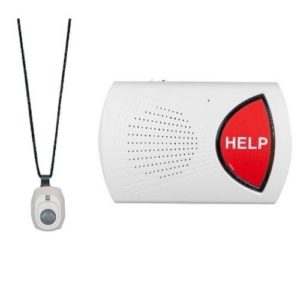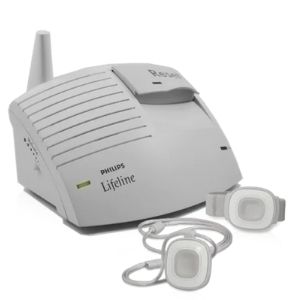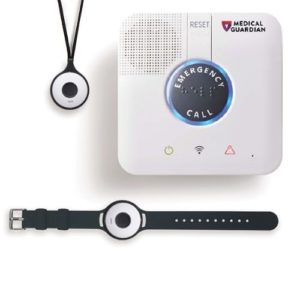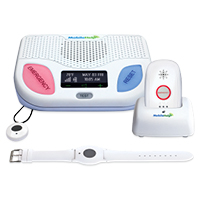GetSafe Medical Alert Review
GetSafe medical alert systems are self-installed, streamlined, and affordable. It takes only a few minutes to set up a GetSafe system, and its monitoring professionals are polite and responsive.
While you do need to pay an initial equipment fee for a GetSafe system, the professional monitoring service is the same from package to package. So whether you’re opting for the smallest or largest kit, it’s $24.95 every month after that.
GetSafe pricing
GetSafe is among the most affordable medical alert systems. For around $80 down and $24.95 per month, you can get started. Compared to fee-heavy systems like Life Alert, GetSafe offers better value for the same peace of mind.
The basic package for most systems includes only a base station and a pendant. GetSafe’s Starter Kit comes with one voice-activated wall button, a base station, and a pendant. It costs a little more up-front than systems like Bay Alarm Medical’s landline kit, but you get more equipment for the price. Plus, the monitoring price doesn’t change with the number of accessories you buy. It costs $24.95 to have your system monitored, whether you have two buttons or ten.
Data effective 06/03/2021. Offers and availability subject to change.
GetSafe has three equipment plans that all include a lanyard button, base station, and wall buttons, but you can purchase add-ons to customize your system. Best of all, you can try out a GetSafe medical alert system for 30 days and if you don't like it, you can return it—no questions asked.
Helpful additions include a GPS pendant with fall detection, so you can get help whether you’re at home or away. You can also purchase additional buttons for your home. Fall detection is an extra $10 per month.
How GetSafe medical alert stacks up
Data effective 06/03/2021. Offers and availability subject to change.
While GetSafe isn’t the cheapest medical alert system, it does deliver the best value of all the systems we’ve reviewed. Sure, you’ll have to pay more upfront for any of the equipment packages, but after that, it’s only $24.95 per month.
Bay Alarm Medical’s cheapest system is only a few dollars less and requires a landline for that low price. Medical Guardian costs more than both systems for all the standard features. All three charge the same rate for fall detection in your equipment, but that extra $10 per month can save you in a dire situation.
GetSafe tech and equipment
GetSafe’s medical alert system includes must-haves like an emergency call pendant and base station with each product package. But it’s the only medical alert kit we’ve encountered that adds more advanced equipment to sweeten the deal. If you’ve tried a medical alert system and found the wearables uncomfortable, the wall buttons are a great alternative.
GetSafe standard wall button
Most medical alert systems offer a wall button. GetSafe’s button is waterproof and has a cellular connection to your base station so that you can install it anywhere in your home. Experts recommend placing wall buttons in areas like the base of your stairs or the shower. The bright red button is easy to see and recessed into the device to reduce false alarms.
GetSafe voice-activated wall button
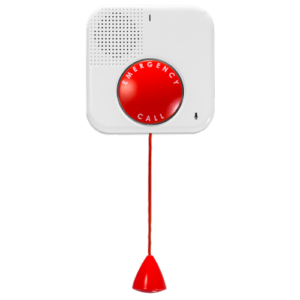
Like the name suggests, a voice-activated wall button lets you contact monitoring professionals by calling for help. This accessory can be a lifesaver, especially if you’ve fallen and can’t reach other medical alert buttons. But this particular device allows you to call for help three ways: say “Call 911. Call 911.”, pull its cable, or press the button. It’s also waterproof and wireless, so you can place it anywhere in your home.
GetSafe is one of the few medical alert systems that includes a voice-enabled button in its starter kit. Most services consider this device an add-on, so we're impressed that it's included even in the most affordable plan.
GetSafe GPS monitoring
Accidents can happen anywhere, so having an alert device that works wherever you go can bring peace of mind. The GetSafe GPS button is small and stylish, has up to 120 hours of battery life, and works with AT&T’s 4G LTE network. When you press the button, you’ll connect with a monitoring professional through the two-way audio. Fall detection is also available with this device, making it easy for help to find you if something goes wrong.
GetSafe customer service
GetSafe has several resources if you need assistance or have questions. The website offers a live chat feature that puts you in touch with a customer representative. You can also speak to a customer rep on the phone. And there's an FAQ and support section on the site.
The customer service that matters most is GetSafe’s emergency response. When you press an emergency button, you’ll get a quick response from one of GetSafe’s monitoring professionals. These pros are polite, responsive, and helpful.
It’s essential to have a reassuring voice on the other line in an emergency, and that’s precisely what GetSafe provides with medical alert and home security services. The only drawback is that Get Safe doesn't offer multilingual support, which can be a dealbreaker for some families.
Final word
GetSafe offers more equipment for your money than most medical alert systems. You get the standards like a base station and wearable alert button, but it also includes wall buttons (a major perk if you don’t like wearables).
We like the affordable flat rate for professional monitoring, and the folks you get on the other line are professional and helpful in an emergency. If the downpayment for the equipment doesn’t bother you, GetSafe is worth a look.
How we reviewed GetSafe
We dove deep into the world of medical alert systems such as GetSafe, Life Alert, Bay Alarm Medical, and more. During this process, we compared prices, equipment features, and customer service reviews to learn more about them. We combed through GetSafe’s instruction manuals and product lists, as well as dozens of positive and negative reviews from real customers. By comparing GetSafe to similar services, we got a better picture of who this service works best for and what to watch out for when shopping for a medical alert system. Learn more about how we wrote this and other reviews by reading our full methodology.
FAQ
Yes, both the wall buttons and wearables are waterproof. Slippery surfaces in showers and bathtubs can lead to falls and accidents, so it’s especially important to have some source of help.
It’s understandable to budget your cash, but falls are a serious threat to seniors of all activity levels. Most medical alert systems, including GetSafe, charge $10 per month for devices that can sense a fall. These sensors call for help if they detect sudden changes in height, speed, and pressure that resemble a real fall.
Whether you’re home or away, there are several ways first responders can find you. Your home base and its accessories are tied to your home address, so when you call for help, the monitoring professionals will send emergency responders to your home. If you’re out and about, a GPS pendant can help pinpoint your location. Some medical alert systems are better than others when it comes to locating you remotely. Philips Lifeline, for example, uses five types of locating technology to find you in an emergency, making it a smart choice for active adults.
Traditionally, medical alert and home security systems connect to monitoring centers through your home’s landline. While you can still find a system that uses your home phone connection, cellular monitoring has become popular in recent years.
Cellular monitoring uses radio signals to connect your devices. You won’t have to worry about your medical alert system affecting your cellphone bill. They run separately from your home or personal phone line. Systems like this allow you to place sensors and buttons anywhere in your home, making it ideal for active adults or anyone in a larger house.
Related articles on SafeWise
The post GetSafe Medical Alert Review appeared first on SafeWise.
Article source here: GetSafe Medical Alert Review


